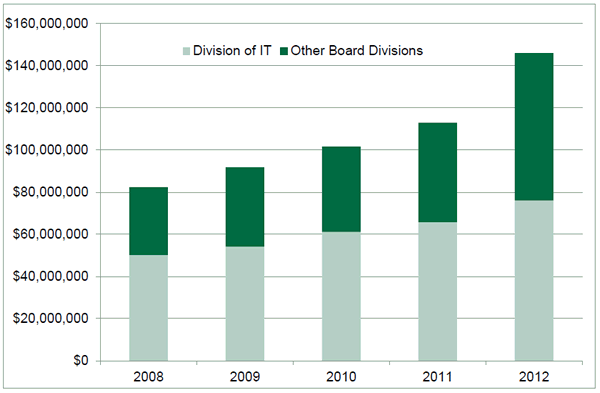IN THIS SECTION
Board Report: 2014-IT-B-003 February 26, 2014
Opportunities Exist to Achieve Operational Efficiencies in the Board's Management of Information Technology Services
available formats
-
Executive Summary:
PDF | HTML -
Full Report:
PDF | HTML - Accessible version
Introduction
Objectives
The Board of Governors of the Federal Reserve System (Board) has developed a strategic framework for 2012-2015 that highlights as key priorities the achievement of operational efficiencies and the reduction of costs. In support of these strategic priorities, our audit objective was to determine how information technology (IT) services are managed across Board divisions and identify areas where operational efficiencies could be achieved. Appendix A provides our detailed scope and methodology.
Background
The Board relies on a variety of IT services to accomplish its mission. These services include applications management, help-desk operations, compliance management, and technical operations management. The Board's governance structure for managing IT services consists of centralized and decentralized organizational responsibilities. The Division of Information Technology (Division of IT) provides centralized IT services that are leveraged by Board divisions. These services include setup and maintenance of Microsoft Windows-based computers, applications development, and help-desk operations. The Director of the Division of IT is responsible for ensuring that these centrally provided IT services are budgeted for and implemented in accordance with the Board's policies and procedures.
Individual Board divisions also perform IT services in support of their business needs. In some instances, these services overlap with those provided centrally by the Division of IT. For example, several Board divisions engage in their own systems development and help-desk activities for applications supporting their business processes. In other instances, Board divisions perform IT services to support specific needs. For example, one division maintains a network of Apple Macintosh computers for desktop publishing and video editing. Another division maintains a separate Linux-based infrastructure to support research and statistical applications used by economists and researchers. These decentralized IT services are implemented and managed by the divisions in which they are performed.
An increasing percentage of the Board's total costs for IT services are occurring outside the Division of IT and are thus being managed in a decentralized manner. Figure 1 below highlights the total costs for IT services at the Board from 2008 to 2012. During this time, IT services costs have grown at an average annual rate of 15 percent to a total of $146 million in 2012. Costs attributable to the Division of IT have grown by about 10 percent per year on average, while those incurred by other Board divisions have grown by approximately 23 percent per year on average. As a result, while the Division of IT accounted for 61 percent of the Board's total expenditures for IT services in 2008, this amount had decreased to 52 percent by 2012.
Figure 1: Board IT Services Costs, 2008-2012

Source: Total costs were obtained from the Board's financial management system by utilizing cost centers used by divisions to track IT services costs.
